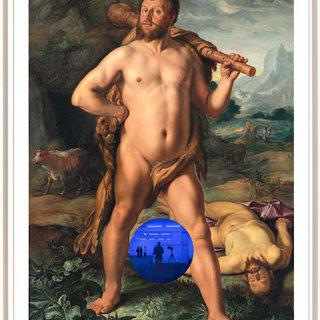About The Work
The Gazing Ball pieces trigger questions about the inherent dialogue between art works and their viewers in the most tangible way, as the viewers see themselves encapsulated within each work. Reflecting the onlookers’ physicality, Koons’s globes serve as portals, guiding viewers into these often misunderstood masterpieces, where art history meets contemporary pop culture, while never avoiding the viewer’s own visage in the engagement and experience of these famous pieces. For Koons, the act of viewing these pieces is as essential as their own objective histories, and while he cannot force a conversation face to face with each original simultaneously, the presentation here is an excellent start.
- Art Observed December 2015
In conceiving the Gazing Ball print series, Koons imagined the prints’ reflective element as being perfectly flat and almost imperceptibly thin. To meet these criteria, he collaborated with the research lab at Corning, a 166-year-old company with unparalleled expertise in glass science and optical physics. The result, produced by the Corning Specialty Glass Plant in Bagneaux sur Loing, France, is a custom-poured, optically perfect, one-millimeter thick circle of mirrored cobalt blue glass.
Looking at the Gazing Ball works, the viewer sees oneself reflected in the mirrored surface at the same time as one sees the print. This juxtaposition of art historical reference with the viewer’s present-day reflection invites a dialogue about the meaning of time and how we transcend it. “This experience is about you,” says Koons, “your desires, your interests, your participation, your relationship with this image.” He says that the images he used—some of the most famous in art history—are not intended to represent the canon, but are rather “works that I enjoy... my cultural DNA.” He also points out that many of the artists referred to in the series have influenced one another: “Monet is always referencing Rubens... Manet is referencing Raphael... Everybody enjoyed Titian.”
The Gazing Ball print series raises important questions about the act of looking, reflection (actual and metaphorical), and the relationship between the pictures. This is “not about being a copy,” Koons says. “This is about this union, the concept of participating. Everybody’s in this dialogue of sharing enjoyment and pleasure.”
Courtesy of Two Palms
About Jeff Koons
From The Magazine
- Interviews & Features: How THE SKATEROOM founder stops kids wiping out
- Interviews & Features: ANATOMY OF AN ARTWORK Untitled (I Shop Therefore I Am) 1987/ 2019 by Barbara Kruger
- Interviews & Features: 2020 Vision
- Art 101: What to Say About Your New David Salle Print
- News & Events: Prada Marfa, Satan, and Magnetic Dogs: The Upcoming Art Books to Get Excited About
Archival pigment print on Innova rag paper, glass
Frame Dimensions: 52 13/16 x 37 5/16 inches
Signed and dated lower margin. Comes with a certificate of authenticity.
About The Work
The Gazing Ball pieces trigger questions about the inherent dialogue between art works and their viewers in the most tangible way, as the viewers see themselves encapsulated within each work. Reflecting the onlookers’ physicality, Koons’s globes serve as portals, guiding viewers into these often misunderstood masterpieces, where art history meets contemporary pop culture, while never avoiding the viewer’s own visage in the engagement and experience of these famous pieces. For Koons, the act of viewing these pieces is as essential as their own objective histories, and while he cannot force a conversation face to face with each original simultaneously, the presentation here is an excellent start.
- Art Observed December 2015
In conceiving the Gazing Ball print series, Koons imagined the prints’ reflective element as being perfectly flat and almost imperceptibly thin. To meet these criteria, he collaborated with the research lab at Corning, a 166-year-old company with unparalleled expertise in glass science and optical physics. The result, produced by the Corning Specialty Glass Plant in Bagneaux sur Loing, France, is a custom-poured, optically perfect, one-millimeter thick circle of mirrored cobalt blue glass.
Looking at the Gazing Ball works, the viewer sees oneself reflected in the mirrored surface at the same time as one sees the print. This juxtaposition of art historical reference with the viewer’s present-day reflection invites a dialogue about the meaning of time and how we transcend it. “This experience is about you,” says Koons, “your desires, your interests, your participation, your relationship with this image.” He says that the images he used—some of the most famous in art history—are not intended to represent the canon, but are rather “works that I enjoy... my cultural DNA.” He also points out that many of the artists referred to in the series have influenced one another: “Monet is always referencing Rubens... Manet is referencing Raphael... Everybody enjoyed Titian.”
The Gazing Ball print series raises important questions about the act of looking, reflection (actual and metaphorical), and the relationship between the pictures. This is “not about being a copy,” Koons says. “This is about this union, the concept of participating. Everybody’s in this dialogue of sharing enjoyment and pleasure.”
Courtesy of Two Palms
About Jeff Koons
From The Magazine
- Interviews & Features: How THE SKATEROOM founder stops kids wiping out
- Interviews & Features: ANATOMY OF AN ARTWORK Untitled (I Shop Therefore I Am) 1987/ 2019 by Barbara Kruger
- Interviews & Features: 2020 Vision
- Art 101: What to Say About Your New David Salle Print
- News & Events: Prada Marfa, Satan, and Magnetic Dogs: The Upcoming Art Books to Get Excited About
Published by Two Palms, NY.
- This work is framed.
- Ships in 10 to 14 business days from New York.
- This work is final sale and not eligible for return.
- Questions about this work?
- Interested in other works by this artist or other artists? We will source them for you.
- Want to pay in installments?
Contact an Artspace Advisor
advisor@artspace.com































